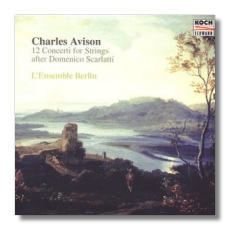
The Internet's Premier Classical Music Source
Related Links
- Latest Reviews
- More Reviews
-
By Composer
-
Collections
DVD & Blu-ray
Books
Concert Reviews
Articles/Interviews
Software
Audio
Search Amazon
Recommended Links
Site News
 CD Review
CD Review
Charles Avison

12 String Concertos after Scarlatti (1744)
Concerti Grossi for 2 Violins, Cello & Continuo
- Concerto Grosso #1 in A Major
- Concerto Grosso #2 in G Major
- Concerto Grosso #3 in D minor
- Concerto Grosso #4 in A minor
- Concerto Grosso #5 in D minor
- Concerto Grosso #6 in D Major
- Concerto Grosso #7 in G minor
- Concerto Grosso #8 in E minor
- Concerto Grosso #9 in C Major
- Concerto Grosso #10 in D Major
- Concerto Grosso #11 in G Major
- Concerto Grosso #12 in D Major
L'Ensemble Berlin
Koch Schwann 3-1318-2 DDD 2CDs: 59:38, 59:38
Charles Avison (1709-1770) was an English composer (also an organist, a harpsichordist, a teacher, and a music critic) who didn't content himself merely with writing his own works. Part pragmatist, part impresario of sorts, he "borrowed" music from the European mainland and reconfigured it for performance and enjoyment in England. This might sound a little strange to us moderns, but actually it was not an unusual practice in the Seventeenth and Eighteenth Centuries; composers frequently borrowed from each other and from themselves. (Bach, for example, in some of his writing for the harpsichord, made use of Vivaldi's works.)
Avison constructed a set of twelve string concertos from at least twenty-nine of Domenico Scarlatti's keyboard sonatas. Each of the concertos is in four movements, and each movement corresponds to a particular sonata by Scarlatti. Sometimes Avison reuses sonatas. For example, the first movements of the first two concertos both use the same sonata (Kirkpatrick 91/Longo 176). The two movements sound different, however, because Avison alters the scoring, the key, or the relative prominence of the voices. In some cases, Avison has changed the tempo of the original to suit his purposes. For example, a quick Scarlatti sonata can become a slow Avison concerto movement, and vice-versa. Finally, for nine movements, it has not been possible to identify where Avison got his material. These movements might have come from as yet unidentified works by Scarlatti or other composers, or they might even be the work of Avison himself!
Scarlatti's sonatas, particularly when played on the harpsichord, frequently make a brilliant, virtuosic impression. Avison's arrangements turn them into mellow yet charming works: when the work of one is divided among many, there's bound to be less excitement. Nevertheless, Avison showed taste and discernment in not only going after Scarlatti, but in finding sonatas that would sound good next to each other. The results are the epitome of Baroque "drive time" music; the brain is fed and jangled nerves are soothed.
L'Ensemble (why "L'Ensemble"?) Berlin is, of course, a German ensemble. The booklet notes don't share any information about who they are. The number of musicians performing here is quite small, however; this is not a chamber orchestra. They seem to be playing modern instruments. My guess that this is so comes, in part, from the fact this recording was made in 1985. Period instruments were commonly used by then, but such smoothness of execution as is found here was much less common. The engineering, like the music and the music-making, has no sharp edges.
Copyright © 2002, Raymond Tuttle


















